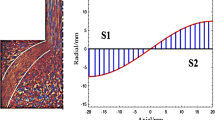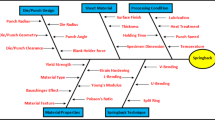Abstract
A single-stage, precision, symmetrical L-bending process is developed, which employs a forming-load control die for progressive sheet-metal forming of a circuit-breaker. It is targeted to replace the traditional two-stage symmetrical L-bending process, which features rough bending followed by fine sizing/adjustment to meet the required geometrical tolerances. The new process requires optimization since the die controls springback caused by the pressing load imparted to the shoulder by the same die. The Taguchi method is thus used to optimize the process design using an elastoplastic finite element method in terms of the tilt angle after springback and the leg length of the resulting bent region. The finite element predictions of the optimized process are in excellent agreement with the experimental data and there are no cases of failure.








Similar content being viewed by others
References
Ling, Y. E., Lee, H. P., & Cheok, B. T. (2005). Finite element analysis of springback in L-bending of sheet metal. Journal of Materials Processing Technology, 168(2), 296–302.
Kumar, K. D., Appukuttan, K. K., Neelakantha, V. L., & Naik, P. S. (2014). Experimental determination of spring back and thinning effect of aluminum sheet metal during L-bending operation. Materials & Design, 56, 613–619.
Buang, M. S., Abdullah, S. A., & Saedon, J. (2015). Effect of die and punch radius on springback of stainless steel sheet metal in the air V-die bending process. Journal of Mechanical Engineering and Sciences, 8, 1322–1331.
Özdemir, M., Gökmese, H., Dilipak, H., & Yilmaz, V. (2015). Characterization of microstructure and bending response of sheet material: Influence of thickness. Journal of Advanced Materials and Processing, 3(1), 3–14.
Thipprakmas, S., & Rojananan, S. (2008). Investigation of spring-go phenomenon using finite element method. Materials & Design, 29(8), 1526–1532.
Chen, F. K., & Ko, S. F. (2011). Deformation analysis of springback in L-bending of sheet metal. Advanced Science Letters, 4(6–7), 1928–1932.
Chatti, S., & Hermi, N. (2011). The effect of non-linear recovery on springback prediction. Computers & Structures, 89(13–14), 1367–1377.
Chatti, S., & Fathallah, R. (2014). A study of the variations in elastic modulus and its effect on springback prediction. International Journal of Material Forming, 7(1), 19–29.
Jamli, M. R., Ariffin, A. K., & Wahab, D. A. (2015). Incorporating feedforward neural network within finite element analysis for L-bending springback prediction. Expert Systems with Applications, 42(5), 2604–2614.
Valinezhad, M., Etemadi, E., Hashemi, R., & Valinezhad, M. (2019). Experimental and FE analysis on spring-back of copper/aluminum layers sheet for a L-die bending process. Materials Research Express, 6(11), 1165h4.
Song, J. H., Huh, H., Kim, S. H., & Park, S. H. (2005). Springback reduction in stamping of front side member with a response surface method. AIP Conference Proceedings, 778(1), 303–308.
Gassara, F., Hambli, R., Bouraoui, T., El Halouani, F., & Soulat, D. (2009). Optimization of springback in L-bending process using a coupled Abaqus/Python algorithm. The International Journal of Advanced Manufacturing Technology, 44(1–2), 61–67.
Kuo, C. C., & Lin, B. T. (2012). Optimization of springback for AZ31 magnesium alloy sheets in the L-bending process based on the Taguchi method. The International Journal of Advanced Manufacturing Technology, 58(1–4), 161–173.
Kitayama, S., & Yoshioka, H. (2014). Springback reduction with control of punch speed and blank holder force via sequential approximate optimization with radial basis function network. International Journal of Mechanics and Materials in Design, 10(2), 109–119.
Adzman, M. S., & Zakaria, A. (2014). Springback-free sheet metal structural part design by topography optimization. Applied Mechanics and Materials, 606, 171–175.
Hong, S., & Hwang, J. (2014). Bead optimization to reduce springback of sheet metal forming using high strength steel. Journal of the Korean Society of Manufacturing Technology Engineers, 23(4), 350–354.
Jafari, M., Lotfi, M., Ghaseminejad, P., Roodi, M., & Teimouri, R. (2015). Numerical control and optimization of springback in L-bending of magnesium alloy through FE analysis and artificial intelligence. Transactions of the Indian Institute of Metals, 68(5), 969–979.
Salvi, H., Mestry, S., & Kavatkar, T. (2016). Experimental investigation for minimization of spring back in L bending using Taguchi design of experiments. International Journal for Innovative Research in Science & Technology, 2(9), 35–42.
Reddy, P. V., Krishnudu, D. M., Pranavi, U., & Ramulu, P. J. (2019). Optimization of the forming parameters in U-bending for punch force and springback using Taguchi method. In Advances in computational methods in manufacturing, 75–84. Springer
El Mrabti, I., Touache, A., El Hakimi, A., & Chamat, A. (2021). Springback optimization of deep drawing process based on FEM-ANN-PSO strategy. Structural and Multidisciplinary Optimization, 64, 321–333.
Eom, J. G., Chung, W. J., & Joun, M. S. (2014). Comparison of rigid-plastic and elastoplastic finite element predictions of a tensile test of cylindrical specimens. Key Engineering Materials, 622, 611–616.
Chang, M. J., Kim, G. H., Lee, C. J., Kim, B. M., Lee, S. B., & Ko, D. C. (2011). Progressive process design of integrated part for mobile phone. Transactions of Materials Processing, 20(2), 110–117.
Park, K. G., Moon, H. G., Oh, S. K., & Joun, M. S. (2020). Development of combined sheet metal forming and plate forging of a metal seal part of hub bearing for an automobile. Transactions of Materials Processing, 29, 194–202.
Joun, M. S., Moon, H. G., Choi, I. S., Lee, M. C., & Jun, B. Y. (2009). Effects of friction laws on metal-forming processes. Tribology International, 42, 311–319.
Joun, M. S. (2020). Recent advances in metal forming simulation technology for automobile parts by AFDEX. IOP Conference Series Materials Science and Engineering, 834, 012016.
Mathews, P. G. (2005). Design of Experiments with MINITAB. ASQ Quality Press.
Author information
Authors and Affiliations
Corresponding author
Additional information
Publisher's Note
Springer Nature remains neutral with regard to jurisdictional claims in published maps and institutional affiliations.
Rights and permissions
About this article
Cite this article
Cho, M., Kim, S. & Joun, M.S. Optimal Process Design of an Optimal, Single-Stage, Symmetrical L-Bending Process Employing Taguchi Method with Finite Element Method, and Experimental Verification Thereof. Int. J. Precis. Eng. Manuf. 23, 395–404 (2022). https://doi.org/10.1007/s12541-022-00631-4
Received:
Revised:
Accepted:
Published:
Issue Date:
DOI: https://doi.org/10.1007/s12541-022-00631-4




